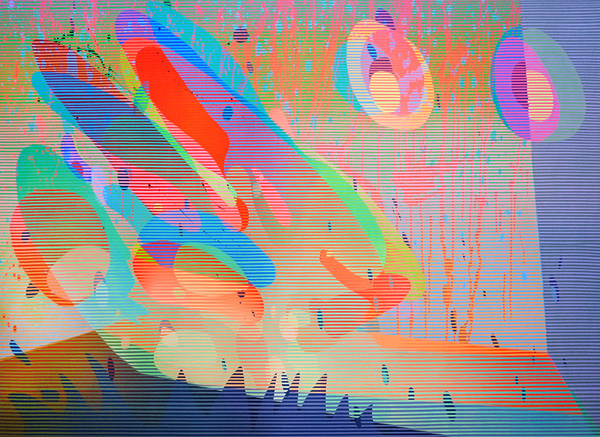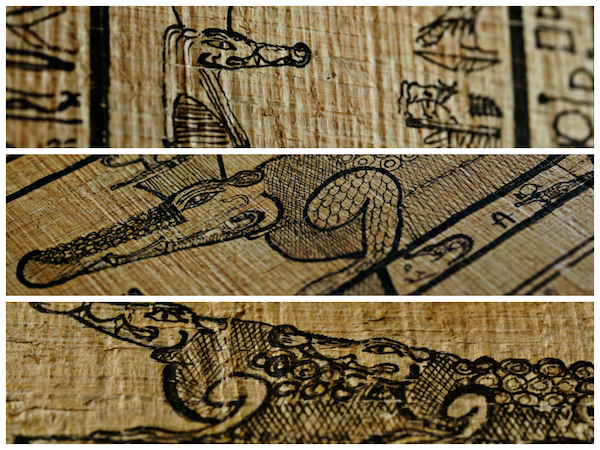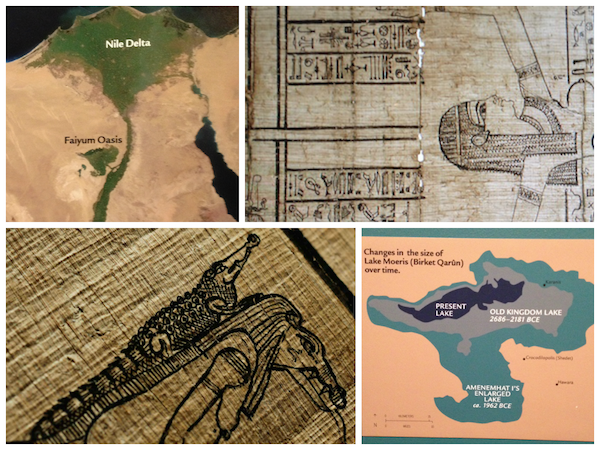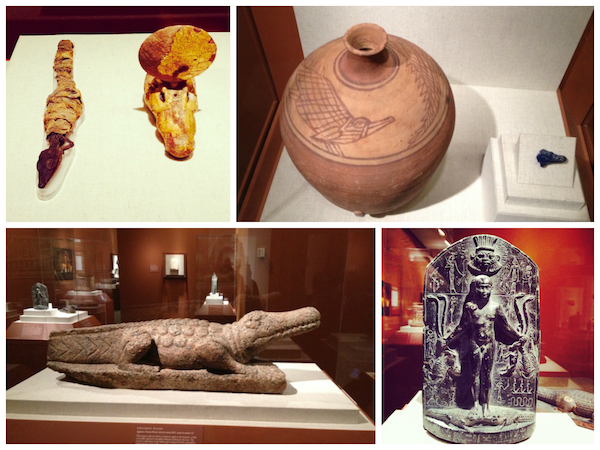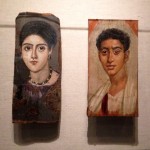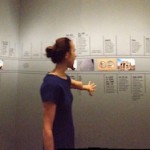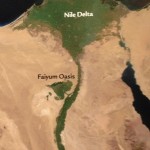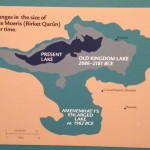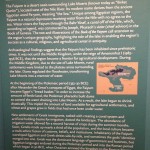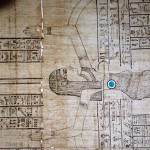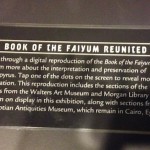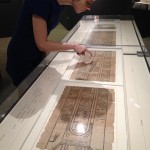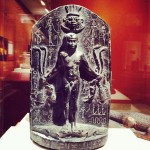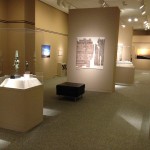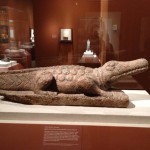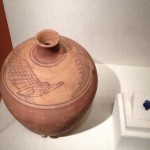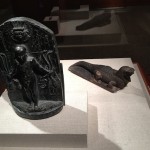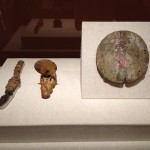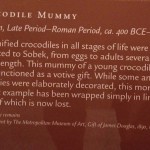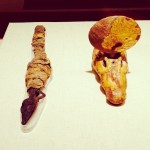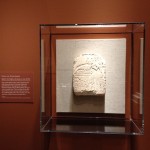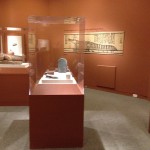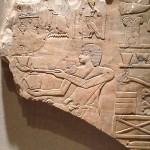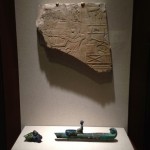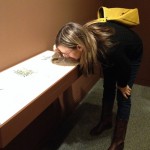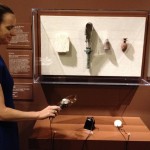Unlike most Egypt exhibits, which present a broad survey of cultural objects from many thousands of years, “The Book of the Faiyum” at The Walters Art Museum in Baltimore is different. It centers on a unique parcel of land called The Faiyum, a distinct oasis of green surrounded by desert on the Nile that formed when a man-made lake was drained approximately four thousand years ago. Although small, the Faiyum was a prosperous region, south and separated from the larger Egyptian kingdoms. This exhibit presents objects and artworks made during the reign of the Romans in Egypt, from the late 1st century BCE and the second century CE.
 Curator Dr. Marden Nichols and the Faiyum time line.
Curator Dr. Marden Nichols and the Faiyum time line.
Not unlike our Baltimore, the Faiyum developed its own mythology and personality, and it probably also suffered from a similar inferiority complex, since it was comparatively small and separate from mainstream culture. What did this tiny cultural gem need to establish a unique identity? That’s right. A PR campaign.
Enter ‘The Book of the Faiyum,’ a twenty foot long miracle of Ancient Egyptian branding. Different than the more widely known ‘Book of the Dead,’ which functioned as a how-to manual for a successful afterlife, ‘Faiyum’ presents a unique community attempting to represent itself in the most powerful way possible. It’s a minority viewpoint, depicted as it would like to be seen by the larger culture. It turns out cultural identity branding is nothing new. If Baltimore’s myth of over-the- top boosterism is a familiar story (“The Greatest City of America”?) the message of the ‘Book of the Faiyum’ rings true with an ironic, self-referential twist.
Although two thousand years old, the twenty-foot long papyrus scrolls were divided into foot-long chunks and sold off in the 19th century. The Walters owns several of the largest, most intact sections of the book, and this exhibit is a rare opportunity to see the Walters’ pages united with other fragments from the Morgan Library & Museum in NY and the Egyptian Antiquities Museum in Cairo. Only when combined does the structure of the mysterious text becomes clear: the book of the Faiyum presents a symbolic topographical map of Egypt, with the Faiyum’s lake at the center of the vision and Egypt’s other regions portrayed as surrounding, subordinate areas.
Although Faiyum residents worshipped a pantheon of Egyptian gods consistent with those of larger Egypt, their local deity, Sobek, was based on the teeming crocodiles in the Faiyum Lake. Sobek is most often represented as a man with the head of a crocodile, but was also depicted as a crocodile, or other hybrid animals. Once you understand this key information the text is clarified: the Crocodile gods are repeated throughout the document in central locations but were also combined with all the other Egyptian gods, to turn them into crocodile hybrids, too. Faiyum scribes used ‘creative liberties’ in their graphic design to assert the dominance and primacy of their own society over all others, not unlike Baltimore sports fans asserting the primacy of their home team through creative placement of its mascots.
Apart from the anthropological dissection of the scroll, there is much to enjoy from a purely visual standpoint in the Faiyum Exhibit. First, there are the sections of actual scroll, displayed full length in two glass-topped tables. Graphic designers and artist-practitioners who love the .001 Micron Pen will appreciate the elegance of the precise writing and design. The minuscule patterns and details are exquisite and the individual marks, especially the hieroglyphs, manage to be loose yet maintain a perfect balance between negative and positive space.
In the rest of the exhibit, Walters’ curator, Dr. Marden Nichols, manages to create a rich menagerie of objects to enhance and contextualize the scrolls’ significance. Objects in the exhibition include highly realistic Egyptian Funerary Portraits, which uncannily resemble the ‘MICA Portrait Style’ developed by Paul Moscatt and Abby Sangiamo in the 1980’s, and inspired a generation of Baltimore painters. Unlike all the other objects, the two portraits of a man and woman are painted in a life-like, yet loose way and the glinting light on their eyes, lips, and hair, as well as fleshy skin tones, make them more akin to an eighteenth century Manet than Ancient Egypt.
Also included are carvings, jewelry, and pottery displayed in vitrines to be viewed from all sides. There are crocodiles and crocodile gods everywhere, so much so that the curator joked she thought of herself as “The Crocodile Hunter” for the past year. A giant pink granite crocodile sculpture is an imposing presence in a middle gallery, and an infinitesimal baby crocodile mummy is displayed in partially unwrapped cloth, with its decorative mask and sun disc.
The show ends in a predictable ‘interactive’ room where visitors can sniff scents of Egyptian incense, play with musical instruments, and write a note on papyrus to leave for the Walters’ staff. It’s a nice try, but this room can’t compete with the dazzling objects of antiquity in prior galleries. Instead, this exhibit could have benefitted from a short video documentary or some type of screening to make the complexities of the show more clear, as the idea behind the show is dense and subtle.
From a contemporary art standpoint, there is a lot to love in this exhibition. The show exemplifies a stylistic versatility that elegantly jumps from realism to abstraction with variants between, in keeping with the practice of contemporary art after modernism. There are rigid and complex systems in place to depict different kinds of ideas, but these systems meander and break down within individual works. For example, a carved stone sculpture with a highly modeled face transitions into a simplified body resembling a Brancusi base. Or, a realistically proportioned animal will be covered with highly stylized patterns.
Rather than creating confusion, these jumps in rendering styles are the most intriguing aspect of the works presented in Faiyum. They reflect different modes of symbolic communication and thinking, and are incredibly similar to the methods modern artists use to represent ideas today.
The best contemporary artists know how to choose the most effective media and method of depiction to communicate complex ideas, and often use metaphorical language. Visiting ‘The Book of the Faiyum’ at The Walters is an opportunity for contemporary artists to consider the intersection of media and content in their own work, as well as inspiration for future projects — and a little branding thrown in won’t hurt, either.
The Book of the Faiyum with be on special exhibit at The Walters Art Gallery through January 5, 2014! Get over there asap. More information at The Walters Website.
* Author Cara Ober is the Editor at Bmoreart.
